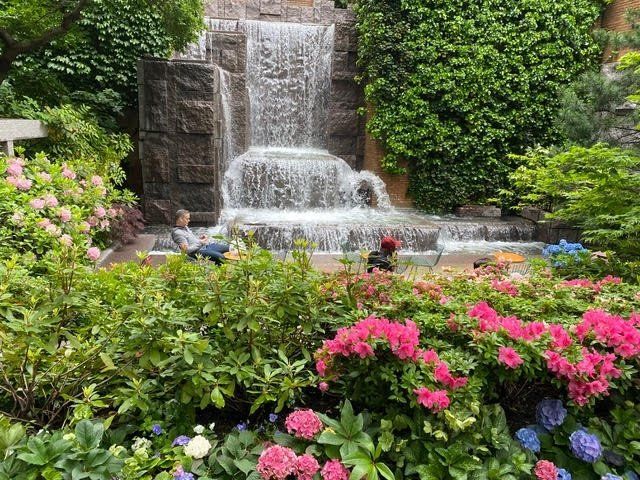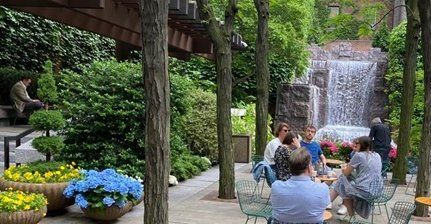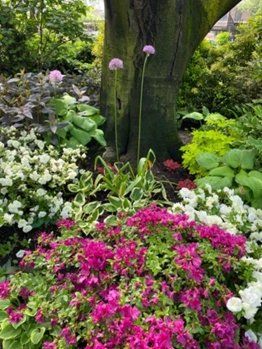Jewels in the Heart of New York
Clanging jackhammers and honking cars assaulted my ears during a recent New York City trip. But after walking up five steps and into Greenacre Park, I hear only the rush of a 25-foot waterfall and babbling of a manmade brook. Even the jackhammer noise next door vanishes.

Smaller than a tennis court, this plant-filled park on East 51st Street is home to 12 honey locust trees plus Japanese maples, star magnolias and a Japanese umbrella pine. Planters of blooming azaleas, pansies and hydrangea invite walkers to enter what a sign calls a “private park for public enjoyment.”


This spring’s Advanced Master Gardener Regional Training focused on parks and inspired me to look beyond museums and explore the city’s green spaces. Central Park is fabulous, but so are small parks scattered around the city. My favorite garden jewels are Greenacre Park in Midtown and Jefferson Market Garden in Greenwich Village.
During eight days in Manhattan, I failed to keep a brisk New York pace while my friend and I walked 12 miles daily between subway rides. As we roamed from Harlem to the Lower East Side, green spaces beckoned me to pause and admire greenery thriving in a city estimated to be 90% concrete.
Greenacre Park – sandwiched in East Midtown between a synagogue and an apartment building – was across from my hotel. It was funded by Abby Rockefeller Mauze’s Greenacre Foundation and designed by Hideo Sasaki, former chair of Harvard’s Department of Landscape Architecture. The park, which replaced a store and garage, opened in 1971 with evergreen and seasonal flowers that fulfill Mauze’s wish for a place to “find moments of serenity in a busy world.” The pocket park has won numerous awards, is on the National Register of Historic Places and is maintained by Greenacre Foundation staff.
Three miles south in Greenwich Village, Jefferson Market Garden blooms in a triangle between 6th Avenue, Greenwich Avenue and West 10th Street. A farm market gave way in the 1930s to the 11-story Women’s House of Detention whose inmates included actress Mae West.
After the prison was demolished in 1971, residents lobbied for the 0.4-acre spot to become a community garden. They were victorious, and in 1975 the first flowers bloomed in a park designed by landscape architect Pamela Berdan. The city owns the land, but volunteers maintain the garden and its greenhouse. They emphasize organic practices and perennial plants.


Bird houses dangle from star magnolias, dogwoods and weeping birch trees while flowers embrace a circular path dotted with benches. Something is always in bloom -- from witch hazel and snow drops in the winter to azaleas and roses in the spring, and wildflowers in the summer. Bird watchers have spotted more than 40 varieties, including downy woodpeckers and black-and-white warblers. A koi pond and fountain help birds stay hydrated.

Jefferson Market Garden’s mission is “to provide stewardship for a beautiful garden where the community and visitors can enjoy tranquil surroundings in our hectic urban environment.”
Greenacre Park at 217 E. 51st Street is open daily from 8 a.m. to 6 p.m. from April through December. https://greenacrepark.org
Jefferson Market Garden at 10 Greenwich Avenue is open from 10 am. to 6 p.m. Tuesday through Sunday from April through October. https://www.jeffersonmarketgarden.org
Here is a list of gardens to discover when you visit New York City: https://blog.gardenuity.com/a-guide-to-the-secret-gardens-of-nyc/

